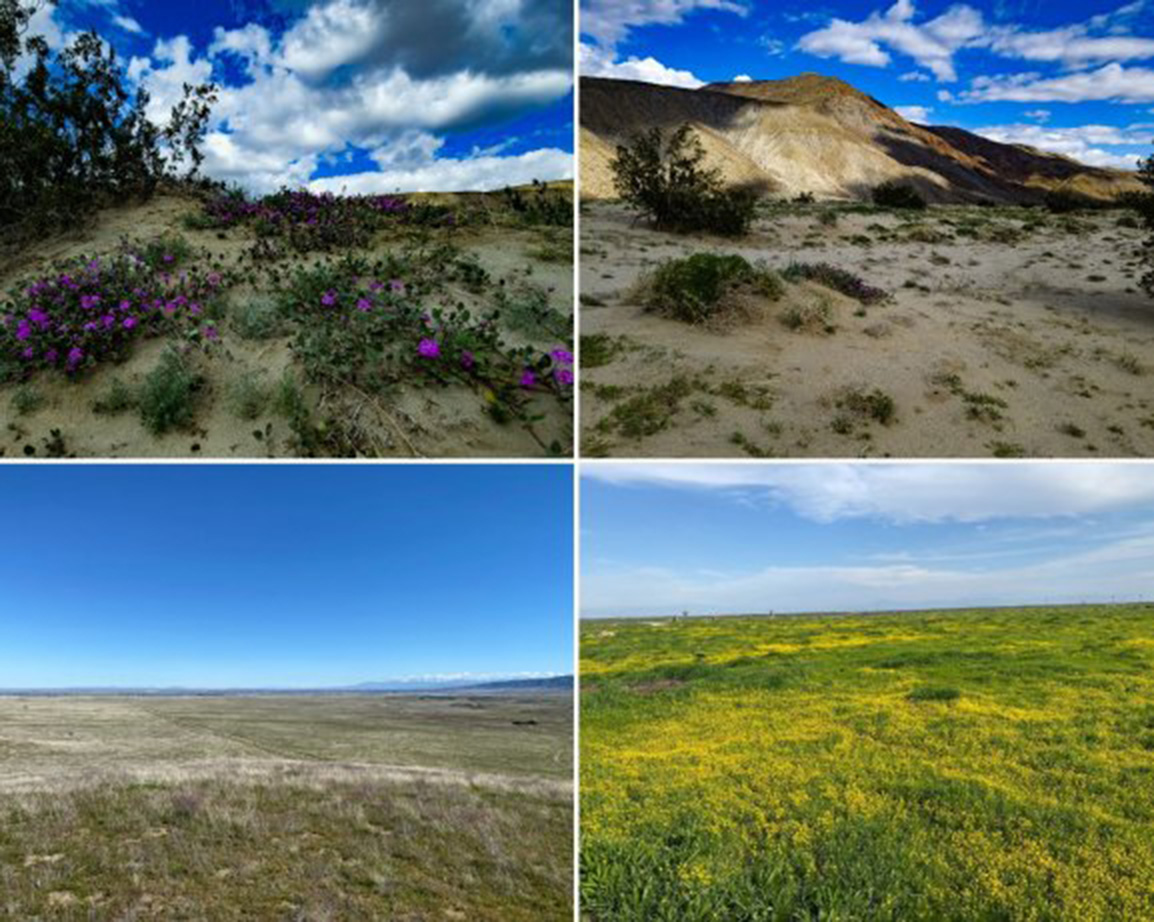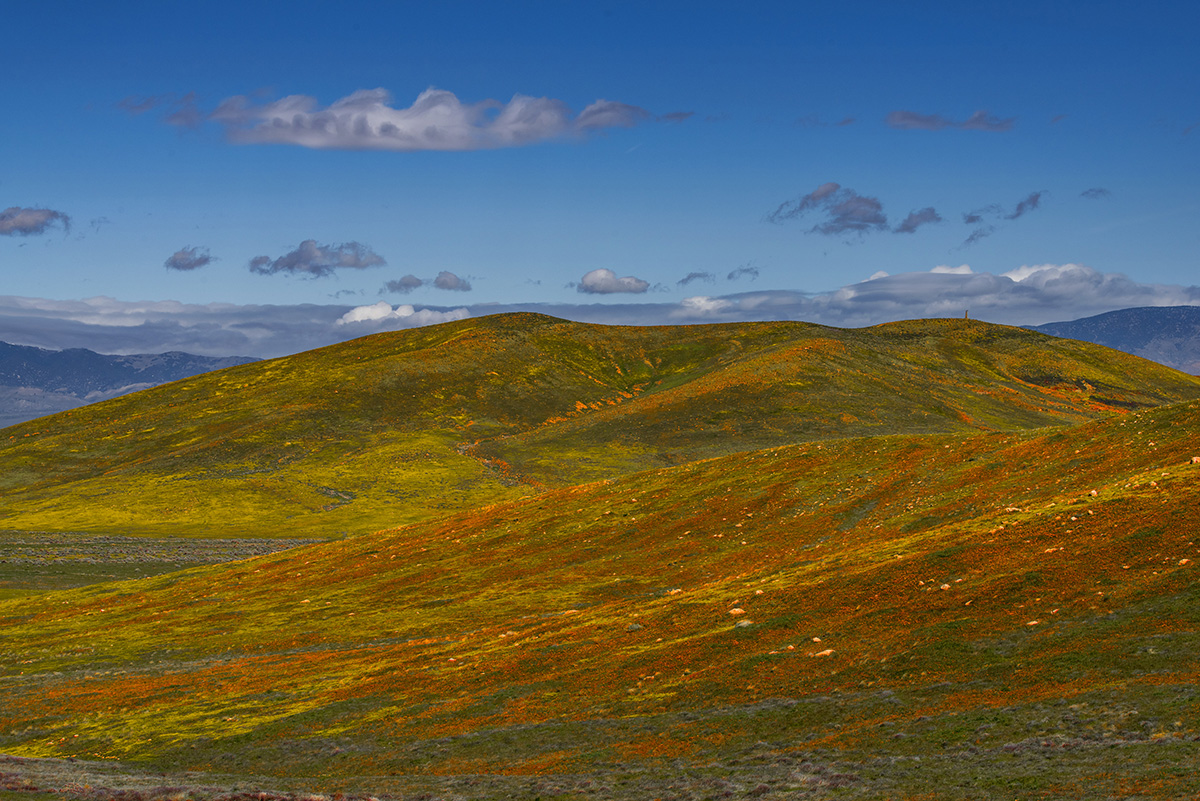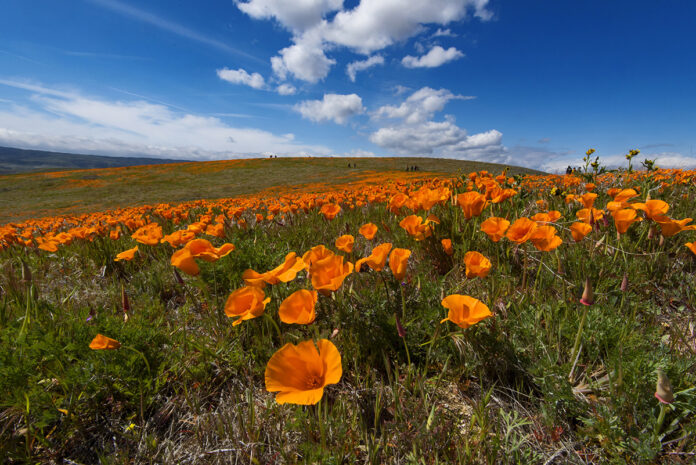This spring, California’s desert state parks might be covered in lots of different colors from wildflowers. California State Parks wants all visitors to enjoy them safely.
“The last few years, California has been lucky to see amazing wildflower blooms in many public lands, including state parks,” said State Parks Director Armando Quintero. “We welcome everyone to see this natural wonder and ask everyone to help keep it beautiful by staying on marked trails and only taking photos, not flowers.”
Current Bloom Update
Depending on the park, visitors might see lupine, coreopsis, desert sunflowers, evening or brown-eyed primroses, desert bells, desert poppies, or desert lilies.

Anza-Borrego Desert State Park: Flowers are starting to show up in Borrego Springs along Henderson Canyon Road, the lower sandy parts of Coyote Canyon, and the southern part of the park along Highway S2 southeast of Agua Caliente County Park. Also, areas near June Wash heading northeast toward Fish Creek and Arroyo Tapiado are starting to bloom with early flowers like primrose, phacelia, and wooly sunflower. If driving south on Highway S2, it’s best to use a four-wheel-drive vehicle on any unpaved roads in the park.
Antelope Valley California Poppy Reserve State Natural Reserve: A few individual poppies have already started blooming. From mid-March to May, this park expects a variety of wildflowers to bloom. Poppies, fiddleneck, and red stem filaree have grown in large quantities throughout the Poppy Reserve.
Red Rock Canyon State Park, Eastern Kern County Onyx Ranch State Vehicular Recreation Area, Chino Hills State Park, Hungry Valley State Vehicular Recreation Area, Fort Tejon State Historic Park: These parks should have good wildflower blooms from mid-March to May, and throughout the spring.
For those planning to visit areas with blooming flowers, State Parks is giving tips on how to explore safely and responsibly, especially in the desert parks where recent storms might have changed the landscape.

Understanding the Area
Cell phone coverage might be unreliable or nonexistent in some parks, so it’s important to be prepared.
Before visiting, research your state park destination online and download a map, especially if you’re going to a desert area. Many GPS and map apps might lead you to dirt roads that require four-wheel drive vehicles.
Know the capabilities of your vehicle and which areas allow off-road vehicle recreation.
Try to visit the parks during weekdays and arrive early to avoid crowds.
When admiring wildflowers, wildlife, or taking photos, make sure to pull off the road. Keep roadways clear for vehicle traffic.
Leave a detailed itinerary of your trip with a family member or friend, including departure and return times, the location you’ll be visiting, and the names of everyone in your group. This helps law enforcement know your whereabouts in case of a rescue.
Checking the Weather
Before your trip, check the weather forecast and prepare for various weather conditions.
Make sure your clothing and equipment are suitable for the expected weather.
Respecting the Landscapes
Each park has its own unique landscapes, so stick to designated trails whenever possible. Be gentle in the desert and avoid trampling flowers.
Only take photographs of the blooms; picking flowers is not allowed.
If dogs are permitted, keep them on leash and only on designated roads, in campgrounds, and picnic areas. Dogs are not allowed on hiking trails or in wildflower fields. Never leave dogs unattended in vehicles, as temperatures inside can become lethal.
Drone use might be prohibited. If allowed, obtain a filming permit from the respective state park units.
Help keep the landscapes clean by packing out any trash you bring in.
Knowing Your Body’s Limitations
Bring plenty of food and water, as there may not be restaurants, gas stations, or stores near the bloom areas.
Stay hydrated by drinking water before your visit to avoid heat-related emergencies.
Outdoor conditions can change rapidly, especially in the desert, so pack sunscreen, a hat, layers of clothing, and closed-toe shoes to prevent injuries.
Walk at a pace where you can comfortably converse. If you’re too out of breath to talk, take a break or slow down.
In case of emergency, dial 911.
In 2017, 2019, and 2023, state parks like Antelope Valley California Poppy Reserve SNR, Anza-Borrego Desert SP, and Ocotillo Wells State Vehicular Recreation Area (SVRA) were covered in wildflowers. This drew hundreds of thousands of people from all over the world to witness this special natural event. The wildflower blooms change each year because of various factors like how much rain falls, when it falls, how much sunlight there is, how humid it is, and the temperature patterns during the seasons. Since California got more rain last fall and winter, park managers expect the wildflowers to be “good” or even “better than usual” this spring, depending on how the weather continues.
Discover more from SNAP TASTE
Subscribe to get the latest posts sent to your email.



